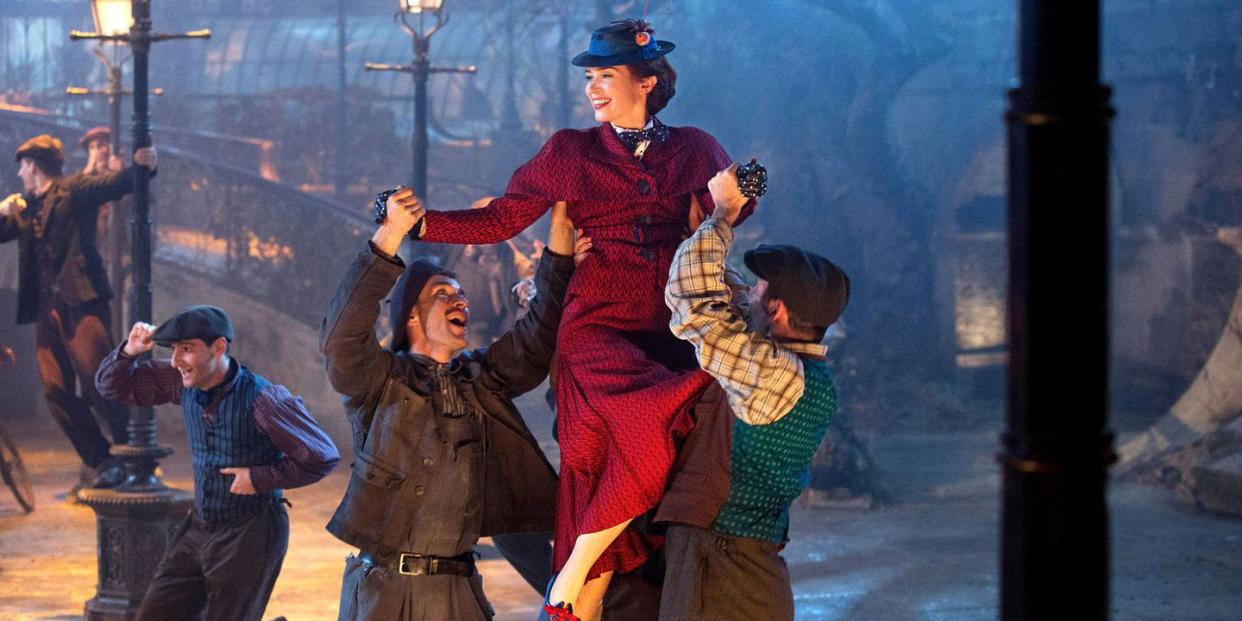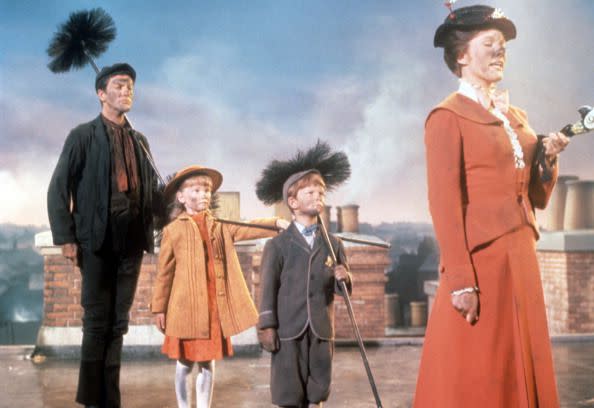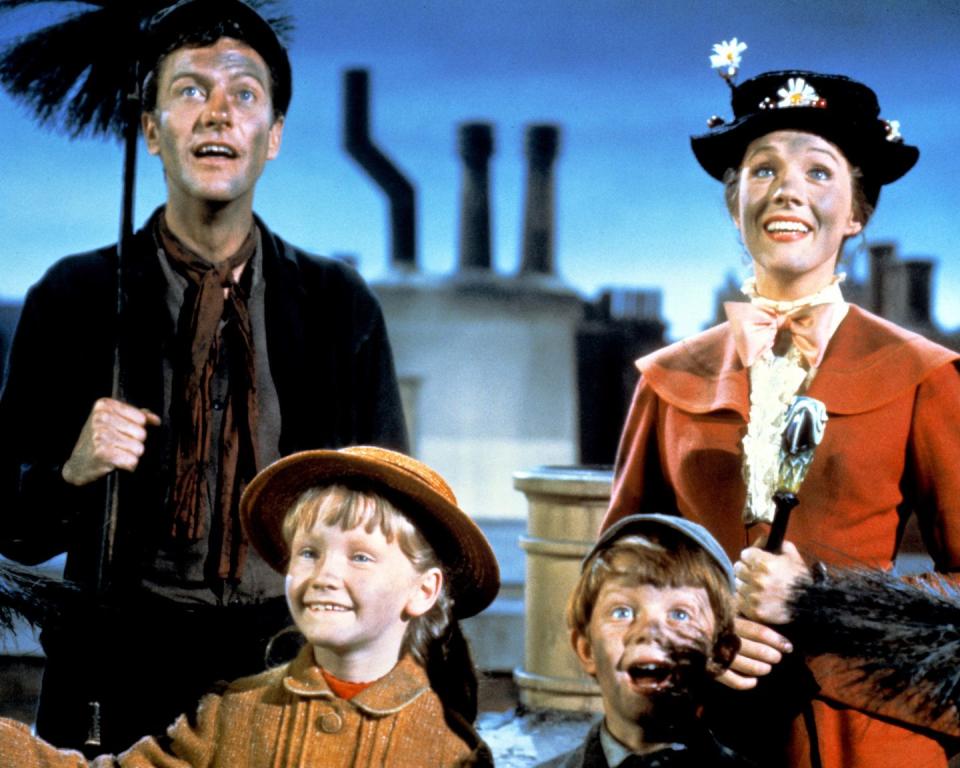The Surprising Inspiration for Mary Poppins

Mary Poppins first appeared in the pages of Australian author P.L. Travers's eight-book series of the same name, published in 1934.
The character is inspired by Travers's real-life great aunt, Helen Morehead.
Travers describes Morehead as someone who was "compact of adventure and romance" and who "kept her own secrets closely."
The mysterious, magical Mary Poppins returns to audiences again (via umbrella, of course!) this December in Disney's forthcoming film, Mary Poppins Returns, starring Emily Blunt. The film is a sequel to 1964 feature film, Mary Poppins, featuring Julie Andrews as Poppins.
But before the beloved British nanny stole hearts on the big screen dancing with penguins and flying kites, she came to life in the pages of Australian author P.L. Travers's eight-book series of the same name-the first of which was published in 1934.
The Poppins that Travers writes of in her books, however, isn't quite as practically perfect in every way as Andrews' character. Travers, who died in 1996 at age 96, describes a sharp and subversive caretaker, who is "vain" and markedly different from the fun, caring woman audiences know from Disney's colorful adaptions.
As depicted in the 2013 film, Saving Mr. Banks (also released by Disney), Travers drew from her own life experiences in order to create her Mary Poppins.

In Travers's semi-autobiographical book, Aunt Sass, released in 2014, she says Poppins is based, in part, on her austere great-aunt Helen Morehead or "Aunt Ellie" who had a "tall, gaunt, graceless frame, a grim face with a long upper lip that curled at the corners when she smiled, and a voice like the Father Bear's voice in the story of Goldilocks."
But that rightness, "coupled with her fierceness," Travers writes in Aunt Sass, "was a wonderful adventure for a child." Much like the Disney-fied Poppins, Morehead was firm, but fanciful.

Travers was born Helen Lyndon Goff in Maryborough, Queensland, in Australia. Her mother attempted suicide when she was a young girl and her bank manager father died when Travers was 7. Biographer Valerie Lawson, author of Mary Poppins, She Wrote: The Life of P. L. Travers, writes that “epileptic seizure delirium” was given as the cause of her father's death, but says Travers “always believed the underlying cause was sustained, heavy drinking,” according a 2005 New Yorker article.
After his death, Travers grew close to her great-aunt Morehead, who was "compact of adventure and romance" and who "kept her own secrets closely," as she describes in Aunt Sass. "There was something about her, something that breathed through the tough outer body-an air, a scent, a whisper-the unmistakable essence of one whom love has struck on the heart. Occasionally, in an old barn, you become aware, though the scent has long been vanished, that once there were apples in the loft. Aunt Sass was like that."
Among Morehead's more whimsical qualities were her pack of small dogs, all of which were named Tinker or Badger ("inheriting the names as though they were titles," Travers says in Aunt Sass). And much like Poppins, she could make up rhymes and songs on the spot to control, discipline, or reward her charges, like:
I looked through the window and what did I see?
A bad little boy who wouldn't take his Tea.
And:
I said, 'I will spank him and send him to bed!'
But I gave him a large Chocolate Drop instead.
The terror and delight of Morehead's manner "infected all children and they adored her as something more than human," Travers writes in Aunt Sass. She was like the "central shaft of a merry-go round" and a "born ancestress and matriarch."
It's unclear how much of Travers's description of Morehead is real, since she "merged truth and fiction," Aunt Sass editor Donna Coonan told The Guardian in 2014. "So nobody has been able to tell which parts are real and which are not … but the stories certainly have autobiographical elements."
Like, for instance, "Mr. Banks is a little bit like my father," Travers told the BBC in an interview before she died. "And Mrs. Banks... is perhaps a little bit like my mother."
The fictional Banks family does seem to be inspired by Travers's own family-albeit a reformed version. Both fathers were bankers (although Mr. Banks is not a drunk) and both mothers were frivolous (although Mrs. Banks is not suicidal).
And, much like Poppins, Morehead was a "great deflater, the enemy of any attempt at whimsy or sentiment," according to the New Yorker. "But she is also an everyday enchantress, a woman who will scold a child for wearing a coat in a warm room but also one who will take her charges to a midnight congress of animals at the zoo, and on an afternoon trip around the world."

It was in 1924, while Travers worked as a journalist at a London newspaper, that she came up with the idea for a novel about a whimsical-yet-stern nanny called Mary Poppins. The name, Travers told the BBC, came from the inscription "M. Poppins" written in the flyleaf of one of her favorite books as a child.
In Aunt Sass, Travers explains she was subconsciously inspired by her real-life aunt-turned-nanny-and didn't realize how much she'd drawn from her own experience until later in life.
"We write more than we know we are writing. We do not guess at the roots that made our fruit," she writes. "I suddenly realised that there is a book through which Aunt Sass, stern and tender, secret and proud, anonymous and loving, stalks with her silent feet. You will find her occasionally in the pages of Mary Poppins."
Travers set her stories in Depression-era London, when the use of nursery nannies was more common. Jonathan Gathorne-Hardy, an expert and author on the social history of the British nanny and public school system, dates the first appearance of the British nanny in the nursery at around 1850, according to a 1973 article in The New York Times. By the end of the second World War, nannies had all but disappeared.
Unlike the Banks family in Disney's film adaption, the middle-class Banks family in Travers's books struggles financially and lives in "the smallest house in the Lane,” which is “rather dilapidated and needs a coat of paint," according to the New Yorker.
It never occurred to Travers, as she began writing the first book, that anyone would want to publish it. "I wrote it for myself," she told the BBC. "My friend said 'I'll take this to a publisher.' I thought 'Well a publisher won't want this!' But, apparently he did."


The book was released in 1934. It caught the attention of Diane Disney, Walt Disney’s daughter, who introduced it to her father.
For 20 years, Travers refused to sell to Disney, for fear they "would sentimentalise her chilly, dark tales of Edwardian nursery life," according to The Guardian. When Travers did eventually sign a deal, she was given a cut of the gross earnings and script approval.
At the picture's premiere, she cried, not tears of joy, but out of anger. The film, she thought, had "done a strange kind of violence to her work," according to the New Yorker.
Travers felt Disney changed her beloved Poppins for the worse. Like, for example, that iconic and emotional moment in the film when Andrews sings of paying a vagrant woman to feed the birds in front of St. Paul's Cathedral. In the book, Travers set the scene a bit differently: Poppins had "little time for the Bird Woman and... on the issue of avian welfare in the capital went further to suggest they should be baked in a pie, according to The Guardian.
"I approved of Julie Andrews. I've seen it once or twice and I've learned to live with it, it's glamorous and it's a good film on its own level," Travers told the BBC. "But, I don't think it's very like my books."
Travers was much more willing to sell the Mary Poppins theatrical rights. In the early 1990s, she made a deal with Cameron Mackintosh, who produced Cats, Les Miserables, The Phantom of the Opera, and Miss Saigon. “She liked him very much,” Diana Rawstron, a lawyer in London and trustee of Ms. Travers’s estate, told The New York Times in 2006. “She felt that he would be true to her original work.”
The Broadway show ran for more than six years, with Ashley Brown as Poppins.
As the release of Mary Poppins Returns approaches, we can’t help but wonder what she’d think of the story plot for the sequel, which will follow the now grownup Banks kids who have children of their own.
Shortly before her death, Travers said she no longer cared to overanalyze fairy tales like Mary Poppins, as it takes away from the story. "The first thing you must do with a fairy tale is to love it and to keep it inside yourself..." she said. "To analyze it seems to me profanity."
('You Might Also Like',)


